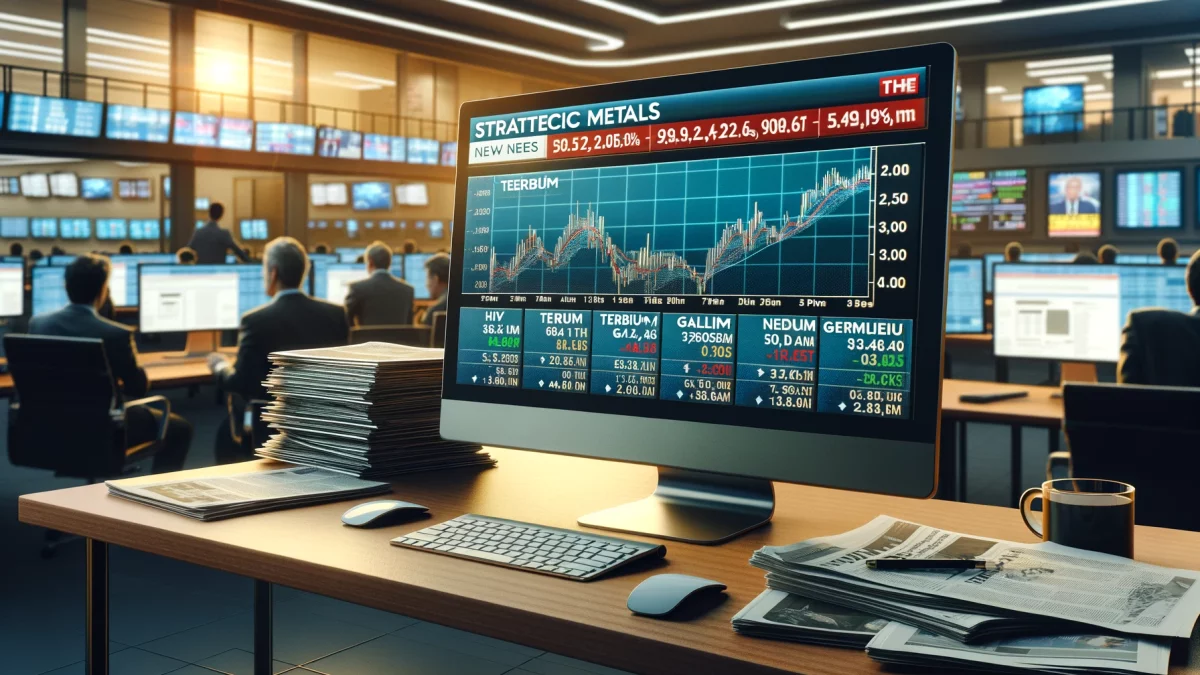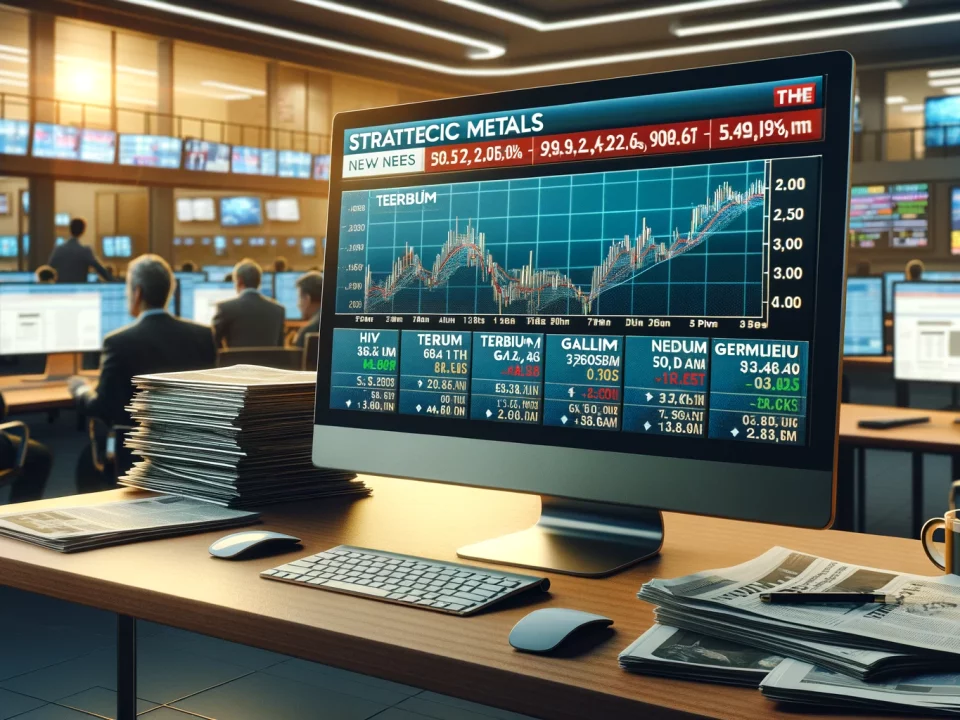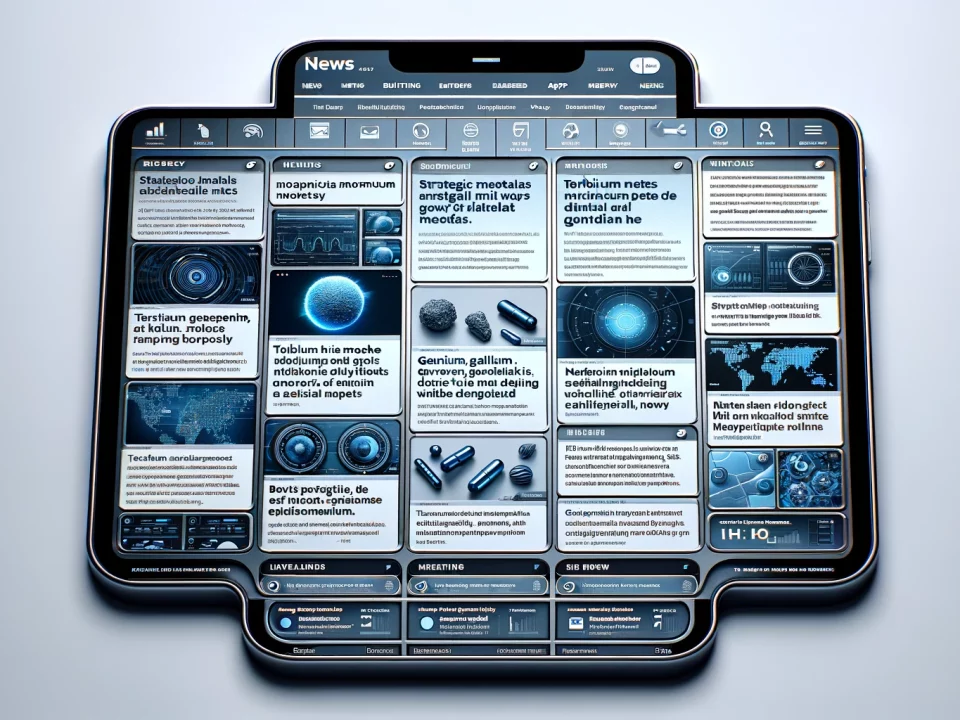
Weekly News Review August 12 – August 18 2024
August 18, 2024
Gallium Prices Up 20% This Year: How Global Demand Is Fueling the Rise
August 27, 2024Welcome to our weekly global round-up.
USA: UNDER SECRETARY OF STATE TRAVELS TO ARGENTINA, ECUADOR AND PERU AUG. 21ST – 29TH.
In search of new critical mineral supply sources, the US. Under Secretary of State for Economic Growth, Energy, and the Environment, Jose W. Fernandez, will travel throughout South America from August 21 to 29. According to the Department of State, the tour aims to engage with “key partners in the Western Hemisphere on critical minerals supply chains” and seek mutually beneficial economic opportunities. Fernandez will visit Ecuador, Peru, and Argentina.
With representatives from the latter, he will sign a memorandum of understanding on critical minerals and open the U.S.-Argentina Energy Security Dialogue.
The move will enable Argentina better to access the Minerals Security Partnership (MSP), catalyzing public and private investment. The MSP is a U.S.-initiated, multilateral association launched in 2022 to strengthen supply chains of critical minerals, comprising 14 states and the European Union as members. In June, South Korea assumed the lead for one year.
Argentina: Major Lithium Producer –
According to the US Geological Survey, Argentina is a major lithium producer, while Peru is home to a significant share of the world’s silver and zinc production. Despite Chile boasting more extensive lithium reserves and more significant production, Argentina has become increasingly more attractive than its neighbor within the so-called lithium triangle, as market intelligence firm S&P Global highlighted in a recent article. Fernandez’s visit to Argentina is not the first instance in which Argentina has become the center of attention regarding critical mineral supply chains. In February, the country hosted a US delegation in the capital of Buenos Aires to discuss essential minerals, among other things.
SOUTH AMERICA TO NORTH AMERICA – RARE EARTHS VALUE CHAIN TAKING SHAPE –
Mined in Brazil and processed in the United States: Ucore Metals and Meteoric signed a supply agreement.
America’s value chain for rare earths continues to take shape. Meteoric Resources, which is developing the Caldeira project in the Brazilian state of Minas Gerais, wants to have its raw materials processed in the United States. A letter of intent has been signed with the Canadian company Ucore Rare Metals, which plans to construct a processing plant in Louisiana that uses a self-developed separation method. As soon as both parties have started production, at least 3,000 tons of total rare earth oxide from the Caldeira project will be delivered to Ucore each year, according to the agreement.
The plant in Louisiana is expected to start operations in the fourth quarter of 2025, with commercial operations scheduled to begin in the first half of 2026. Meteoric expects to receive the construction permit by the end of 2025 and plans to produce mixed rare earth carbonate in the second half of 2027.
According to the companies, the material supplied each year will contain neodymium and praseodymium as well as the coveted heavy rare earths terbium and dysprosium, which have so far primarily been mined in China and Myanmar.
Ucore and Meteoric Already Involved in Supply Chains Outside China –
For both players, these are not the first steps towards establishing alternative supply chains without market leader China. Ucore, which receives support for its projects from the US Department of Defense and the Canadian government, wants to cooperate with the rare earth recycler Cyclic Materials, also based in Canada. In addition, Ucore is developing the Bokan Mountain deposit in Alaska, which, like the Caldeira project, is believed to contain heavy rare earths.
Meteoric’s raw material is to be processed in the US and Europe and could eventually be processed into permanent magnets for technologies such as electromobility and wind power in Latin America.
USA: PENTAGON AWARDS $20 MILLION TO CANADIAN COMPANY –
Electra Battery Materials Corporation will use the funds to advance its facility in Ontario.
The US Department of Defense awards $20 million to Canadian company Electra Battery Materials Corporation for the sustainable production of cobalt sulfate in North America. Electra will use the funds to advance the construction of its planned facility in Temiskaming Shores, Ontario, Canada.
According to the company, the plant north of Toronto will be North America’s first cobalt sulfate refinery capable of producing battery-grade cobalt, which is used in lithium-ion batteries, for example. Electra estimates the annual production to be 6,500 tons—roughly the amount needed to support the production of one million electric vehicles.
In 2023, LG Energy Solution secured approximately 80 percent of the facility’s production over five years to supply its North American battery production. Dr. Laura Taylor-Kale, Assistant Secretary of Defense for Industrial Base Policy, added that the investment will help boost the domestic production of batteries to supply both commercial and defense sectors in North America.
The award to Electra is not the first time the Pentagon has turned to the industry to secure supplies of critical raw materials. Last year, for example, the department announced it would contract US and Canadian firms to produce metal gallium technology.
CHINA: GALLIUM AND GERMANIUM EXPORTS DEVELOP –
Exports of gallium and germanium from China continue to develop differently. As a reminder, export restrictions have been in place for both technology metals since August 2023. Export licenses are required to ship the raw materials abroad.
For July 2024, the Chinese customs authority reported a new record for gallium, which at 11,523 kilograms is significantly higher than last year.
Germanium remains well below the previous year’s figure despite a monthly increase of 2,888 kilograms. The majority of both raw materials went to Germany in July.
DOMINICAN REPUBLIC SEEKS TO UNEARTH RARE EARTH WEALTH:
Caribbean state launches company to mine critical raw materials.
The Dominican Republic’s mining sector mainly produces nickel, bauxite, gold, and silver. President Luis Abinader hopes that this could include rare earths in the future. In a decree on Tuesday, Abinader ordered establishing a state-owned company to explore and mine strategic raw material deposits. The potential revenues of Empresa Minera Dominica (Emidom) are to be invested in infrastructure, education, and health.
According to a statement from Abinader, Emidom will focus on rare earths. The province of Pedernales in the southwest of the country is considered promising for mining this group of raw materials. Bauxite deposits are found there, which are needed to produce aluminum but can also contain high concentrations of rare earths. These could be mined as a by-product.
No information is available on the extent of rare earth deposits in the Caribbean’s largest economy. Last year, researchers from the Engineer Research and Development Center, a division of the United States Army Corps of Engineers, assisted in exploring the mineral resources.
AUSTRALIA: ILUKA RESOURCES – PROFIT DECLINE
Australian mining company Iluka Resources, which specializes in titanium, zirconium, and rare earths, posted a profit of $90 million (AUS$134 million) for the first half of 2024, a decline of over 34 percent compared to the same period last year. The company cites macroeconomic uncertainty that would weigh on the prices of Iluka’s products.
Iluka is constructing a rare earth refinery in Eneabba, Western Australia, and estimates the capital investment will be roughly $1.2 billion. Tom O’Leary, CEO and Managing Director of Iluka, highlighted that the company has one million tons of stockpiled material ready to be processed at the facility, adding that the company would provide a detailed rare earth business update in September.
EUROPE: SWEDEN SUBMITS SEPARATE THREE APPLICATIONS UNDER CRMA (CRITICAL RAW MATERIALS ACT).
Gällivare iron ore mine, Kiruna rare earth deposit, and Lulea industrial site.
State-owned Swedish mining company Luossavaara-Kiirunavaara Aktiebolag (LKAB) has submitted three applications for recognition as strategic projects under the EU’s Critical Raw Materials Act (CRMA). The three projects in the country’s north are an iron ore mine near Gällivare, the Per Geijer rare earth deposit near Kiruna, and an industrial site in the coastal city of Lulea, where LKAB wants to separate phosphorus and rare earths, among other things. The plant in Lulea will initially process material from Gällivare and eventually from Kiruna once the deposit is mined.
With the CRMA, the European Union aims to become less dependent on imports of critical raw materials by ramping domestic mining, processing, and recycling efforts. Strategic projects benefit from an accelerated approval process, which, according to the legislators’ wishes, should only take a maximum of 27 months for mining projects and 15 for processing and recycling ones. The EU Commission will publish an initial list of projects classified as strategic in December.
The discovery of the rare earth deposit near Kiruna made headlines in early 2023 when it was classified as Europe’s largest. This title has since been taken away by neighboring Norway and the Fen deposit (we reported). Yet, both deposits are only in the exploration stages. It takes multiple years or even decades to discover a deposit until it can be mined, as there are numerous steps in between.
RARE EARTH MAGNET RECYCLING: MANY CHALLENGES REMAIN –
More recycling is supposed to bolster European supply chains – the German Raw Materials Agency examines the current situation.
The first EU-wide raw materials law, the Critical Raw Materials Act (CRMA), aims to reduce the union’s import dependence by significantly increasing recycling quotas from 2030. One clear focus here lies on rare earth magnets, indispensable components for the energy and transportation transition, but over 90% come from China. Yet, under one percent of these crucial components are currently being recycled – so how realistic are the CRMA’s targets?
A new study (PDF) by the German Mineral Resources Agency (DERA), conducted by the Fraunhofer IWKS, assesses the current recycling status of magnets made of neodymium-iron-boron (NdFeB) in Germany. These magnets are of the most significant industrial importance due to their high performance.
The result: There are still plenty of challenges on the road to greater supply security. Industrial magnet recycling in Germany and Europe is still in its infancy, even though some technologies have already been available for several years. One reason is the often suppressed prices of Chinese primary magnets. However, the main challenge is the stable and predictable supply of a sufficient quantity of spent magnets. According to the authors, estimates in this regard, which consider sources such as electronic scrap, wind turbines, and automotive applications, vary significantly in some cases. From 2030, for example, generators from wind turbines could increasingly be available for recycling – but the question of the economic viability remains.
The authors recommend setting up effective collection and return systems for NdFeB magnets and financial incentives and political regulations for using recycled raw materials to increase recycling rates. In logistics, obstacles such as the heterogeneity of waste streams and different product life cycles must be overcome. Finally, the authors believe that cooperation between industry and scientific research plays a decisive role in developing sustainable recycling solutions.






